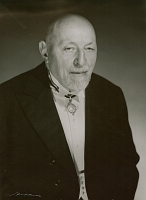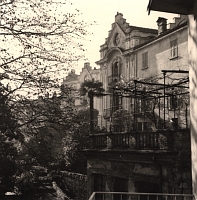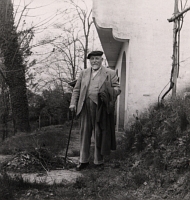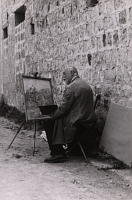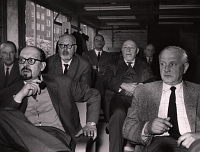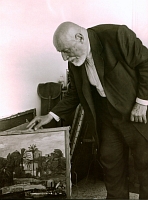Montagnola 1943-1966
1943
In early October, Purrmann receives a visa from the Swiss consulate and is able to flee to Switzerland, going first to his wife’s family in Zurich. He is forced to leave all of his belongings behind in Florence, including his own paintings and his valuable art collection. In Zurich in October, he writes to Hilde Wolf explaining his plans to move to Ticino, to Castagnola, near Lugano: “... I would like, if possible, to move to Ticino. It is best suited for my work, and I must think of my work, for I have been thrust away from it
for so long.” In Castagnola, he spends the winter at the Hotel Boldt. A deposit payment made by Purrmann’s nephew Hans Vollmoeller makes possible his stay in Switzerland, though not without restrictions (he is not permitted to sell paintings or take part in exhibitions).
1944
Purrmann moves to Montagnola on the Collina d’Oro, above Lugano, and resides initially at the Hotel Bellevue; it is run by Signora Ceccarelli, and remains in her family to this day. Purrmann paints portraits of her daughter Gabriella as a small child and later as an adolescent. From Montagnola, Purrmann writes to Brüne on October 8, 1944: “I am a little bit hidden away and very secluded in my life here. My relatives are in Zurich. I could visit them, live with them, but a great timidity holds me back. I fear being drawn into political discussions and the ever-ubiquitous amicability toward Germans annoys me to no end!”
1945
When the war ends in May, Purrmann is in Montagnola. It is around this period that Purrmann cultivates a friendship with the textile artist Maria Geroe-Tobler (“Mareili,” 1895–1963), from St. Gallen. She studied under Paul Klee and Wassily Kandinsky at the Bauhaus in Dessau, and is also on friendly terms with Hermann Hesse. Marino Marini paints a portrait of Purrmann. Purrmann becomes friends with Hesse, also residing in Montagnola, and with the Swiss patron of the arts and collector of African art Hans Coray, who lives in Agnuzzo.
In July and August, Purrmann displays ten paintings at the exhibition „Ausländische Maler in der Schweiz“, which is organized by the Bern Kunsthalle.
In July and August, Purrmann displays ten paintings at the exhibition „Ausländische Maler in der Schweiz“, which is organized by the Bern Kunsthalle.
1946
Early in the year, Purrmann travels to Basel, Zurich, and Konstanz, where he is reunited with his son Robert and his daughter-in-law Mechtild, daughter of the painter Leo von König. In November, he is visited by Fritz Volbach, who attempts in vain to persuade Purrmann to return to Germany.
The artist resumes his efforts as an author. A further article on Matisse appears in the journal Werk.
The artist resumes his efforts as an author. A further article on Matisse appears in the journal Werk.
1947
Important recollections of Purrmann’s, entitled “Erinnerungen an meine Studienzeit,” are published, again in Werk.
1948
Purrmann finally receives a work permit from the Swiss authorities. He moves into the Casa Camuzzi, previously occupied by Hermann Hesse. Over and over again, into the early nineteen-fifties, Purrmann will paint the view from the Casa Camuzzi onto the garden terrace and Lake Lugano. During this period, Purrmann also rents a studio some distance below the Hotel Bellevue: “The tiny little house, sitting all alone above a goat shed in the verdure, was reached by a narrow footpath that wended its way through high meadows, with a marvelous view down into the valley and the town of Agno ...” (Heidi Vollmoeller, 1982). Purrmann is a neighbor of the painter Gunter Böhmer, who had resided at the Casa Camuzzi from 1933 on. Böhmer’s diary „Purrmanniana“ allows a look into the lively personal exchange between the two artists in the years between 1957 and 1961. Later, the painter Georg Meistermann would also live at the Casa Camuzzi. Purrmann reestablishes contact with Elisabeth Heintz, whom he knew from Florence. As Purrmann’s secretary, Heintz assists the artist in the years to come with the administration of his extensive correspondence. In October, Purrmann is able to spend a number of days in Florence.
1949
The idea for a major Purrmann exhibition in Switzerland is largely realized by his Zurich-based niece Heidi Vollmoeller (1916–2004). In September, the two travel together to San Remo and nearby Ospedaletti, where Purrmann paints many watercolors. His niece recalled in 1994, “In 1949, the Museum of Art Lucerne put on a wonderful exhibition of the paintings of Henri Matisse. ... Inspired by this exhibition, I undertook in secret, without the knowledge of my uncle, to interest a number of Swiss museums in the possibility of organizing a Hans Purrmann exhibition. The Museum of Art Lucerne expressed interest on the condition that Purrmann’s paintings would be displayed together with works by the German painter Richard Seewald. Hans Purrmann gave his consent to the condition.”
In April and May, Purrmann contributed five paintings to the exhibition Kunst in Deutschland 1930–1949 at the Kunsthaus Zürich.
Purrmann is named an honorary member of the Hochschule der bildenden Künste in Munich. The text “Die Einheit des Kunstwerks” (The unity of the work of art) is published in the journal Werk.
In April and May, Purrmann contributed five paintings to the exhibition Kunst in Deutschland 1930–1949 at the Kunsthaus Zürich.
Purrmann is named an honorary member of the Hochschule der bildenden Künste in Munich. The text “Die Einheit des Kunstwerks” (The unity of the work of art) is published in the journal Werk.
1950
For the first time after the war, Purrmann travels to Germany, to Lake Constance. He is also reunited with Karl Scheffler in Überlingen. On the occasion of his seventieth birthday in April, he is named an honorary citizen of the city of Speyer, an award he will not accept in person until the following year. He is ill in May and stays at the clinic of St. Anna in Sorengo (Lugano). Purrmann spends August through October in Capo di Sorrento.
Purrmann exhibits a total of sixty-four paintings, twenty-seven watercolors, and twenty-six drawings at the Museum of Art Lucerne. The catalogue foreword is from the pen of Heinz Braune. A still larger touring exhibition, including seventy-nine paintings, begins as a solo show at the Pfalzgalerie Kaiserslautern, progressing onward to Speyer, Mannheim, Stuttgart, Munich, Hamburg, Bremen, and Bochum.
Released at the same time is the first monograph on Purrmann, Der Maler Hans Purrmann. The author is Edmund Hausen, former director of the Museum of Arts and Crafts in Kaiserslautern. Karl Scheffler had been the first choice of authors, but he declined on the grounds of his age.
Purrmann attends the Venice Biennale, where he views works of Max Beckmann, a few months before Beckmann’s death, and the Triennale in Milan. Purrmann is a member of the jury of the Deutscher Künst¬lerbund (Association of German Artists), which exhibits annually in different cities. He finds the traveling and the work on the juries to be increasingly wearisome, although it allows him to deepen friendships with other artists, such as Ernst Schumacher.
He prepares the text “Wandel ist der Künste Weg,” (Change is art’s destiny) although it will not appear in print until published by Göpel in 1961.
Released at the same time is the first monograph on Purrmann, Der Maler Hans Purrmann. The author is Edmund Hausen, former director of the Museum of Arts and Crafts in Kaiserslautern. Karl Scheffler had been the first choice of authors, but he declined on the grounds of his age.
Purrmann attends the Venice Biennale, where he views works of Max Beckmann, a few months before Beckmann’s death, and the Triennale in Milan. Purrmann is a member of the jury of the Deutscher Künst¬lerbund (Association of German Artists), which exhibits annually in different cities. He finds the traveling and the work on the juries to be increasingly wearisome, although it allows him to deepen friendships with other artists, such as Ernst Schumacher.
He prepares the text “Wandel ist der Künste Weg,” (Change is art’s destiny) although it will not appear in print until published by Göpel in 1961.
1951
At the invitation of Matisse, Purrmann travels with Heidi Vollmoeller to Nice and Vence to attend the dedication of the chapel the interior of which Matisse has painted. In the summer, he continues on to Sorrento, a city Purrmann had first visited in the nineteen-twenties. In late fall, Federal President Heuss pays an unofficial visit to Purrmann in Montagnola.
Purrmann becomes a Corresponding Member of the Bavarian Academy of Fine Arts. Emy Roeder creates a bronze bust of Purrmann. Purrmann authors his views on the matter of Kunst ohne Publikum (Art without Audience, published in 1953 and 1955), relating his experiences as a defamed artist in the nineteen-thirties.
Purrmann becomes a Corresponding Member of the Bavarian Academy of Fine Arts. Emy Roeder creates a bronze bust of Purrmann. Purrmann authors his views on the matter of Kunst ohne Publikum (Art without Audience, published in 1953 and 1955), relating his experiences as a defamed artist in the nineteen-thirties.
1952
Another summer in Sorrento. Exhibition and sale of works at the Aargauischer Kunstverein at the Aarau Museum of Arts and Crafts, with a total of seventy-nine works. He is together with his son Robert in Zurich.
Purrmann exhibits successfully within the context of the “New Group” in the Grosse Kunstausstellung München almost until the time of his death. Purrmann is a member of the jury of the Deutscher Künstlerbund in Cologne.
Purrmann exhibits successfully within the context of the “New Group” in the Grosse Kunstausstellung München almost until the time of his death. Purrmann is a member of the jury of the Deutscher Künstlerbund in Cologne.
1953
First return trip to Ischia to paint. Purrmann stays at the same albergo in Porto d’Ischia, looking out over the harbor, as he had in 1924. On Ischia, he encounters such artist friends as Hans Kuhn, Werner Gilles, Eduard Bargheer, and Ernst Schumacher. In Montagnola, he paints a series of self-portraits. To one of these paintings, Hermann Hesse dedicates the poem “Alter Maler in der Werkstatt” (Old painter in his workshop). At the Palazzo Reale in Milan, Purrmann views the Picasso exhibit, which makes an immense impression on him. At an unknown juncture in 1953, he spends fourteen days in Paris. He spends Christmas in Beilstein.
1954
The death of Matisse affects Purrmann deeply. Early in the year, he travels to Florence; in March he is a member of the jury of the Deutscher Künstlerbund in Frankfurt am Main. From there, he travels to Stuttgart and Munich. November in Zurich and in Freiburg where he undergoes medical treatment.
1955
Takes part in the first Documenta in Kassel. Purrmann travels to Palermo to paint on Sicily, but then chooses to go back to Ischia. Barbara and Erhard Göpel are his guests. Purrmann’s health is once again problematic, as he relates to Hesse in November: “But unfortunately I have been, and remain, in the worst conceivable health, and am, thus, in such a bad state that I am no longer able to contend with the business of life, am ceaselessly depressed and unhappy. What is more I am very nearly afraid of people ... ”.
Purrmann is awarded the “Berlin Art Prize for Painting in 1955” with half the usual prize money attached. He refuses to accept. Der Spiegel reports on the matter on April 27: “That the prize amount for painting was cut in half .... must inevitably create a public impression of a ‘devaluation of his art.’” Purrmann is awarded the Great Cross of Merit of the Federal Republic of Germany; he is also named a Knight of the Civil Class of the Order Pour le Mérite for Science and the Arts. Purrmann is a member of the jury of the Deutscher Künstlerbund in Hanover.
Purrmann is awarded the “Berlin Art Prize for Painting in 1955” with half the usual prize money attached. He refuses to accept. Der Spiegel reports on the matter on April 27: “That the prize amount for painting was cut in half .... must inevitably create a public impression of a ‘devaluation of his art.’” Purrmann is awarded the Great Cross of Merit of the Federal Republic of Germany; he is also named a Knight of the Civil Class of the Order Pour le Mérite for Science and the Arts. Purrmann is a member of the jury of the Deutscher Künstlerbund in Hanover.
1956
In Basel, he views the Beckmann exhibition, in Zurich an exhibition of Cézanne. A portrait sculpture of him is made by Gerhard Marcks.
Purrmann is a member of the jury of the Deutscher Künstlerbund in Düsseldorf, where he focuses on Tachisme. He spends an extended period in Lacco Ameno on Ischia, where he paints numerous landscapes.
Purrmann writes a memorial to the painter Rolf Müller-Landau, who founded the Palatinate Secession.
Purrmann is a member of the jury of the Deutscher Künstlerbund in Düsseldorf, where he focuses on Tachisme. He spends an extended period in Lacco Ameno on Ischia, where he paints numerous landscapes.
Purrmann writes a memorial to the painter Rolf Müller-Landau, who founded the Palatinate Secession.
1957
Karl Schmidt-Rottluff, who lives in Ascona near Locarno, visits Purrmann in Montagnola, much to the latter’s pleasure. Purrmann travels extensively through Germany. He is a member of the jury of the Deutscher Künstlerbund in Berlin, goes to museums in Frankfurt am Main and Wiesbaden, and in Mainz is awarded (along with Carl Zuckmayer) the Art Prize of the Rhineland-Palatinate. Afterwards, he goes to Munich to be a jury member for the Grosse Kunstausstellung. Summer in Porto d’Ischia.
1958
In the spring, Purrmann travels to Greece (Athens, Delphi, Olympus) with his son Robert, his daughter-in-law Mechtild, and Heidi Vollmoeller. The trip impresses him greatly, but does not prompt him to paint. After Greece comes a last summer stay on Ischia. Visit to a Modigliani exhibition in Milan and the twenty-ninth Biennale in Venice. Purrmann also goes to the Villa Massimo in Rome.
The Pfälzische Landesgewerbeanstalt Kaiserslautern mounts the exhibition „Hans Purrmann. Werke der letzten Jahre“. Purrmann is represented by a number of paintings at the major retrospective München 1869–1958: Aufbruch zur Modernen Kunst, held at the Haus der Kunst.
His „Denkschrift betreffend die Villa Romana und ihre Weiterführung“ is published.
The Pfälzische Landesgewerbeanstalt Kaiserslautern mounts the exhibition „Hans Purrmann. Werke der letzten Jahre“. Purrmann is represented by a number of paintings at the major retrospective München 1869–1958: Aufbruch zur Modernen Kunst, held at the Haus der Kunst.
His „Denkschrift betreffend die Villa Romana und ihre Weiterführung“ is published.
1959
In early January, Purrmann paints a portrait of Barbara Göpel, whose vivid account of their sessions offer valuable insights into Purrmann’s creative process (see Göpel 1980). Together they watch a film in Lugano on Picasso, which fascinates Purrmann.
After a tiring jury in Wiesbaden, Purrmann stays well into the summer at the Villa Massimo in Rome, where he becomes very ill; it is believed he suffers a stroke at this time. He is in the hospital until October, and relies on a walker and wheelchair thereafter.
After a tiring jury in Wiesbaden, Purrmann stays well into the summer at the Villa Massimo in Rome, where he becomes very ill; it is believed he suffers a stroke at this time. He is in the hospital until October, and relies on a walker and wheelchair thereafter.
1960
Purrmann’s eightieth birthday is the backdrop for his largest solo exhibition yet, including 168 paintings and numerous works of graphic art, held first at the Galerie Vömel in Düsseldorf, then at the Kunstverein Hannover.
The studio immediately adjacent to the Casa Camuzzi, which has been planned for some time, is finished. It is designed to be accessible for Purrmann’s wheelchair. Many artists, collectors, and art historians call on him, and requests for his work as a portraitist also grow.
The slender volume „Hans Purrmann: Landschaften und Stilleben“ appears with a retrospective foreword by the artist himself and an appraisal of his work by his friend, the author Kasimir Edschmid. Under the title, “‘Und lasst uns wieder von Cézanne reden.’ Bemerkungen zum Schaffen und Einfluss Cézannes,” the Cologne Deutsche Zeitung publishes an article that Purrmann wrote in 1958 and 1959 at the suggestion of Erhard and Barbara Göpel.
The studio immediately adjacent to the Casa Camuzzi, which has been planned for some time, is finished. It is designed to be accessible for Purrmann’s wheelchair. Many artists, collectors, and art historians call on him, and requests for his work as a portraitist also grow.
The slender volume „Hans Purrmann: Landschaften und Stilleben“ appears with a retrospective foreword by the artist himself and an appraisal of his work by his friend, the author Kasimir Edschmid. Under the title, “‘Und lasst uns wieder von Cézanne reden.’ Bemerkungen zum Schaffen und Einfluss Cézannes,” the Cologne Deutsche Zeitung publishes an article that Purrmann wrote in 1958 and 1959 at the suggestion of Erhard and Barbara Göpel.
1961
Purrmann designs a large mosaic for the new theater in Speyer; the mosaic, however, is not executed. From August through October, he is in the hospital in Milan. Erhard and Barbara Göpel’s volume on Purrmann’s life, still authoritative today, is published: „Leben und Meinungen des Malers Hans Purrmann anhand seiner Erzählungen, Schriften und Briefe zusammengestellt“. Erhard Göpel also publishes Hans Purrmann. Sommer auf Ischia. The photographer and journalist Hans Kinkel takes powerful portrait photographs of the aged artist between 1961 and 1965, which appear in 1973 under the title Hans Purrmann in Montagnola.
Purrmann receives the Stephan Lochner Medal of the city of Cologne. The Italian state names him a “Commendatore nell’Ordine al Merito della Repubblica Italiana.”
The catalogue of the holdings of the Kohl-Weigand Collection, prepared by Hans-Jürgen Imiela and Wilhelm Weber, gives Purrmann his place alongside Slevogt and Weisgerber. In his article, “Im Gedenken an Werner Gilles,” Purrmann articulates his views on his deceased friend and colleague. He writes memorably in the Stuttgarter Zeitung, on “Das verlorene Menschenbild.”
Purrmann receives the Stephan Lochner Medal of the city of Cologne. The Italian state names him a “Commendatore nell’Ordine al Merito della Repubblica Italiana.”
The catalogue of the holdings of the Kohl-Weigand Collection, prepared by Hans-Jürgen Imiela and Wilhelm Weber, gives Purrmann his place alongside Slevogt and Weisgerber. In his article, “Im Gedenken an Werner Gilles,” Purrmann articulates his views on his deceased friend and colleague. He writes memorably in the Stuttgarter Zeitung, on “Das verlorene Menschenbild.”
1962
The retrospective of Purrmann’s paintings is shown as a touring exhibition in Munich (at the Haus der Kunst), then in Baden-Baden and lastly in Frankfurt am Main. The exhibition encompasses 128 paintings from all periods of the painter’s creative output, and is made possible through the assistance of the artist’s friend and colleague Ernst Schumacher. The opening address is given by the art historian Gotthard Jedlicka of the University of Zurich. Erhard Göpel organized the exhibition and prepared the catalogue. Purrmann reworks a series of past paintings for the show. An interview with Purrmann is filmed in the course of the exhibition.
Purrmann receives the Bavarian Order of Merit from the prime minister president of Bavaria, an honor for which Erhard Göpel had strongly pressed. Purrmann receives the title of “Officier de l’Ordre des Arts et des Lettres de la Republique Française” from the French state.
The summer is spent in Levanto, near La Spezia, on the Ligurian coast. His son finds the remote Villa “Le Lagore.” Here Purrmann’s art could once again emerge in paintings of park benches, fountains, and the villa’s chapel turned studio.
Purrmann receives the Bavarian Order of Merit from the prime minister president of Bavaria, an honor for which Erhard Göpel had strongly pressed. Purrmann receives the title of “Officier de l’Ordre des Arts et des Lettres de la Republique Française” from the French state.
The summer is spent in Levanto, near La Spezia, on the Ligurian coast. His son finds the remote Villa “Le Lagore.” Here Purrmann’s art could once again emerge in paintings of park benches, fountains, and the villa’s chapel turned studio.
1963
An extensive touring exhibition of the complete graphic works travels to Kaiserslautern, Hagen, Ludwigshafen am Rhein, Baden-Baden, and Freiburg. The exhibition catalogue contains a catalogue of works for Purrmann’s graphic art, compiled by Wilhelm Weber, which served as the basis for the authoritative catalogue raisonné published by Angela Heilmann in 1981. Exceptionally bad weather makes the summer in Levanto an unproductive and depressing one for Purrmann.
1964
Another summer in Levanto. Purrmann feels lonely and is tormented by self-doubt. He is awarded the Great Cross of Merit with Star of the Federal Republic of Germany.
1965
The last summer in Levanto. Exhibition of portraits by Purrmann at the Pfalzgalerie Kaiserslautern, with assistance in compiling the works from the artist himself (handwritten lists of paintings in
the Hans Purrmann Archiv). Wilhelm Weber gives the opening address; Purrmann contributes a piece to the catalogue, “Über das Porträt-Malen.” In the November 13 edition of the newspaper Rheinpfalz, he dedicates a “best-wishes address” to the chair of art history at Mainz, Prof. Dr. Gerke, on the latter’s sixty-fifth birthday. In December, Purrmann writes a foreword for the catalogue of his paintings owned by the collector Franz-Josef Kohl-Weigand. At fifty paintings, it is the largest private collection of the artist’s works (today held by the Saarland Museum, Saarbrücken).
1966
In the last months of his life, Purrmann continued to work on portraits of Effi Bantzer and Felix H. Man, the famed photojournalist.
The exhibition of the Franz-Josef Kohl-Weigand collection „Hans Purrmann. Gemälde, Aquarelle, Handzeichnungen und Druckgraphik“ takes place at the Art Historical Institute of the Johannes Gutenberg University in Mainz from January through March.
In the spring, Purrmann is confined to bed, then must be flown to the cantonal hospital in Basel for treatment of pneumonia. After a temporary improvement, Purrmann dies on April 17. His last words are: “Portami i colori!” (Bring me the paints!). On April 22, he was laid to rest in Langenargen, where he was buried next to his wife.
The exhibition of the Franz-Josef Kohl-Weigand collection „Hans Purrmann. Gemälde, Aquarelle, Handzeichnungen und Druckgraphik“ takes place at the Art Historical Institute of the Johannes Gutenberg University in Mainz from January through March.
In the spring, Purrmann is confined to bed, then must be flown to the cantonal hospital in Basel for treatment of pneumonia. After a temporary improvement, Purrmann dies on April 17. His last words are: “Portami i colori!” (Bring me the paints!). On April 22, he was laid to rest in Langenargen, where he was buried next to his wife.






